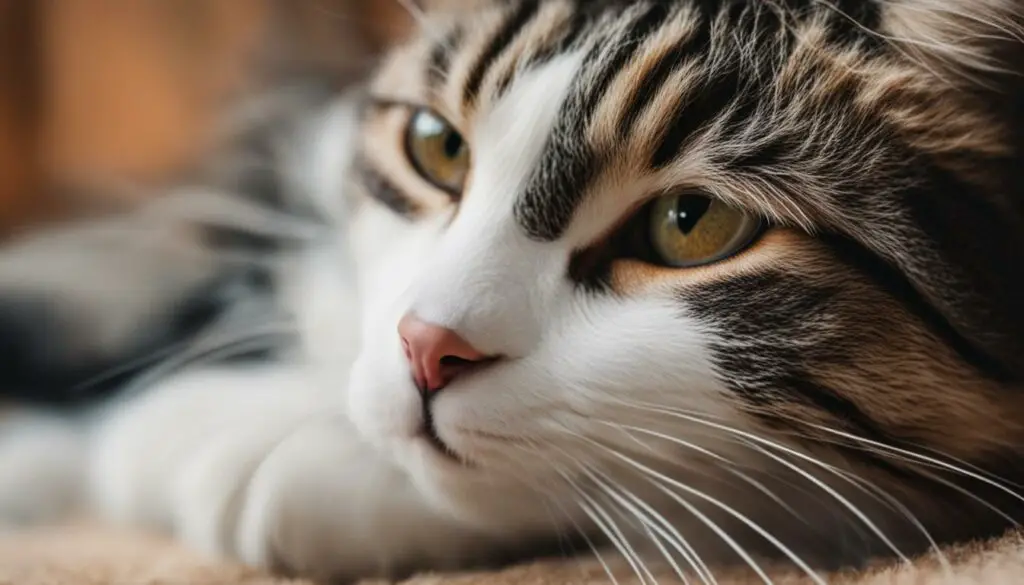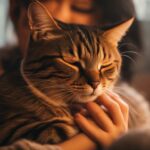Welcome to my blog post on understanding cat behavior! Today, we’re going to explore the fascinating topic of why cats headbutt. It’s a behavior that many cat owners have witnessed and wondered about. So, let’s dive in and uncover the secrets behind this adorable and intriguing feline communication.
Key Takeaways:
- Cat headbutting, also known as cat bunting, is a common behavior that cats use to deposit their pheromones and communicate with their environment.
- Headbutting serves various purposes, including self-soothing, bonding with other cats, marking territories, and creating a sense of familiarity.
- When a cat headbutts you, it can be seen as a sign of trust and affection.
- Not all cats engage in headbutting behavior, and that’s perfectly normal. Each cat has its own unique way of expressing itself.
- Understanding the meaning behind cat headbutting can help deepen the bond between cat owners and their furry companions.
What is Cat Headbutting?
Cat headbutting, or cat bunting, is a common behavior exhibited by cats. It involves a cat rubbing their head against a person or object and then moving to rub their cheek. This behavior is a form of communication and is driven by the use of scent glands located in various parts of their body, including their cheeks, lips, forehead, flanks, paw pads, and tail.
By rubbing these scent glands on a person or object, cats leave their scent behind, creating a colony scent. This scent serves multiple purposes in their social interactions and is an important aspect of their communication through body language.
Understanding cat headbutting and its significance in feline behavior allows us to gain deeper insights into the complex world of cats and strengthen our bond with these fascinating creatures.
Reasons for Cat Bunting
When it comes to cat bunting, there are several reasons why our feline friends engage in this behavior. Understanding the meaning behind cat headbutting can provide us with insights into their social interactions and emotional well-being. Let’s explore the various reasons why cats headbutt:
Bonding with other cats
Cat headbutting plays a crucial role in cat-to-cat communication and bonding. When cats headbutt each other, they are exchanging scents and creating a common scent profile. This shared scent helps establish a sense of belonging and trust among cats, strengthening their social bonds in multi-cat households or outdoor colonies.
Marking their territory
By headbutting objects or people, cats are marking their territory. They have scent glands located on their cheeks, forehead, and other parts of their bodies. When they rub against something, they are leaving their unique scent, indicating that the area or person belongs to them. This form of territorial marking helps cats feel secure in their environment.
Self-soothing
Cat bunting is also a form of self-soothing behavior. When cats rub their heads against objects or people they trust, it releases endorphins that help them relax and feel calm. This behavior is particularly prevalent during times of stress or anxiety, as it provides comfort and reassurance to cats.
Overall, cat bunting serves as a way for cats to communicate, bond with others, mark their territory, and find comfort in their surroundings. It is a fascinating behavior that highlights the complex nature of our beloved feline companions.
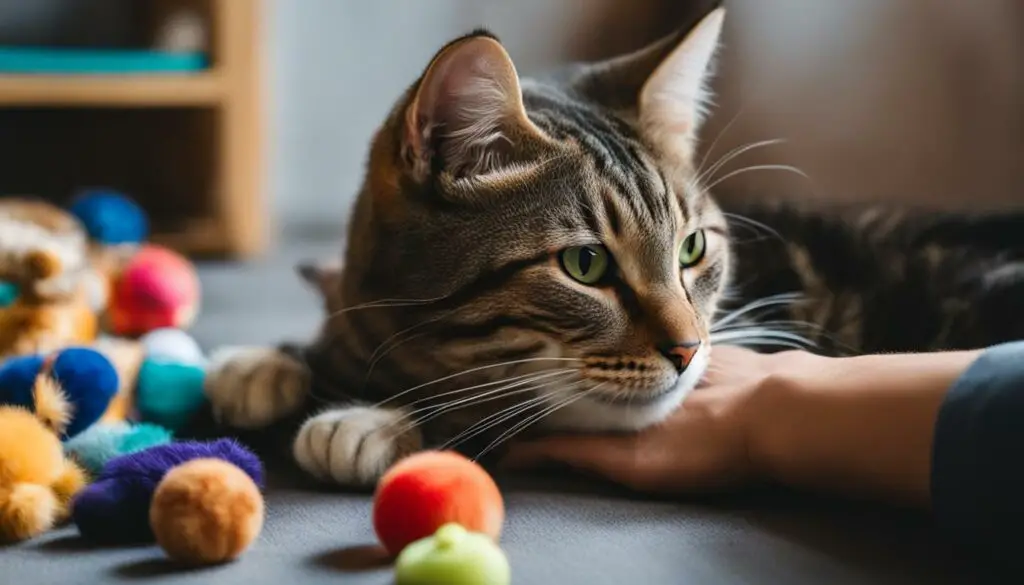
Table: Reasons for Cat Bunting
| Reason | Description |
|---|---|
| Bonding with other cats | Exchange of scents to establish trust and social bonds. |
| Marking territory | Leaving their scent on objects or people to claim ownership. |
| Self-soothing | Releasing endorphins for relaxation and comfort. |
Is Cat Bunting a Sign of Affection?
When a cat headbutts you, it may seem like a simple act of rubbing their head against you. But could it also be a sign of affection? The answer is yes, cat bunting can be considered a display of affection from your feline friend. When a cat headbutts you, it shows that they trust and feel safe with you. They are using their scent glands in their cheeks to mark you as their territory and establish a sense of familiarity. So, when your cat headbutts you, it’s their way of saying “I love you” in their unique feline language.
This behavior is especially common among cats who have formed a strong bond with their owners. By rubbing their scent on you, they are essentially claiming you as their own. It’s a way of marking you as a safe and trusted individual in their social circle. So, the next time your cat headbutts you, feel honored and reciprocate the affection by giving them a gentle pet or a scratch behind the ears.
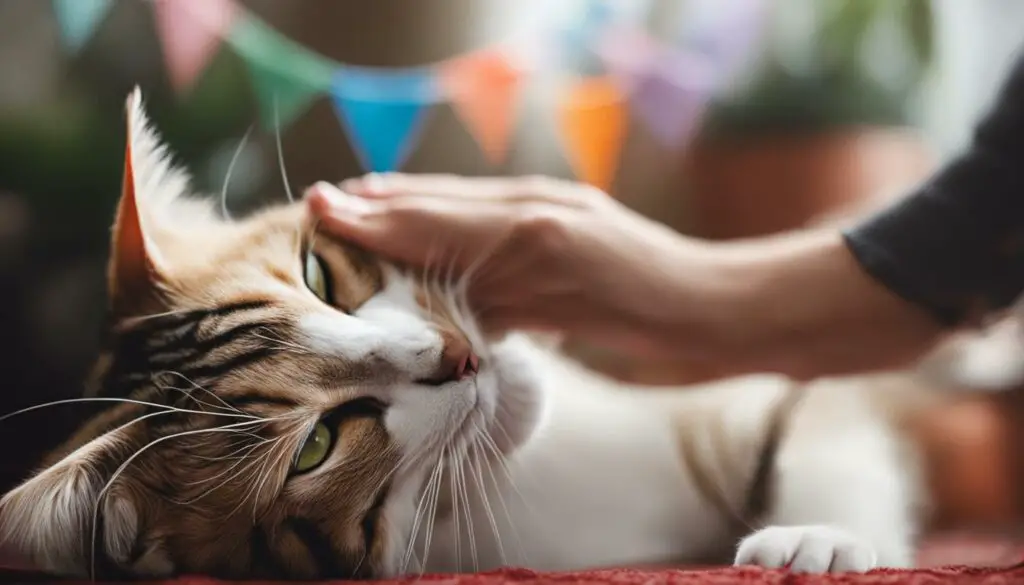
It’s important to note that not all cats engage in headbutting behavior, and that’s okay. Just like humans, cats have their own unique personalities and ways of expressing themselves. Some cats may show their affection in other ways, such as purring, kneading, or giving gentle nips. So, even if your cat doesn’t headbutt, it doesn’t mean they don’t love you. Each cat has their own individual way of showing affection, and it’s important to respect and appreciate their unique behaviors.
Cat-to-Cat Headbutting: Strengthening Bonds Through Scent Communication
When it comes to cat communication, headbutting is not limited to interactions with humans. Cats also engage in headbutting behavior with other cats, using this form of physical contact to establish and reinforce social bonds. This behavior plays a crucial role in creating a colony scent and promoting a sense of familiarity and safety within the feline social structure.
During cat-to-cat headbutting, felines rub their heads and cheeks against each other, allowing them to exchange their unique scents. This scent exchange helps in the creation of a colony scent, which acts as a unifying factor within a group of cats. By sharing scents, cats convey a message that they are part of the same social unit, strengthening their bond and facilitating their interactions.
Cat-to-cat headbutting is not limited to cats living together in the same household. Even cats that encounter each other outside their territories may engage in this behavior to establish a temporary connection. It allows them to communicate their presence and intentions, reducing potential tensions and conflicts. Through headbutting, cats can create a harmonious environment and maintain positive social dynamics.
| Benefits of Cat-to-Cat Headbutting | Examples |
|---|---|
| Promotes bonding and social cohesion | Two cats headbutting each other upon reuniting after a temporary separation |
| Reduces territorial conflicts | Two cats headbutting before engaging in play or exploration together |
| Establishes a sense of familiarity and safety | Neighborhood cats headbutting while encountering each other on the street |
Observing cats engage in headbutting provides a glimpse into their intricate social interactions and their ability to establish and maintain relationships within their feline communities. The next time you witness two cats headbutting each other, remember that they are engaging in a powerful form of communication that strengthens their bonds and fosters a sense of belonging.
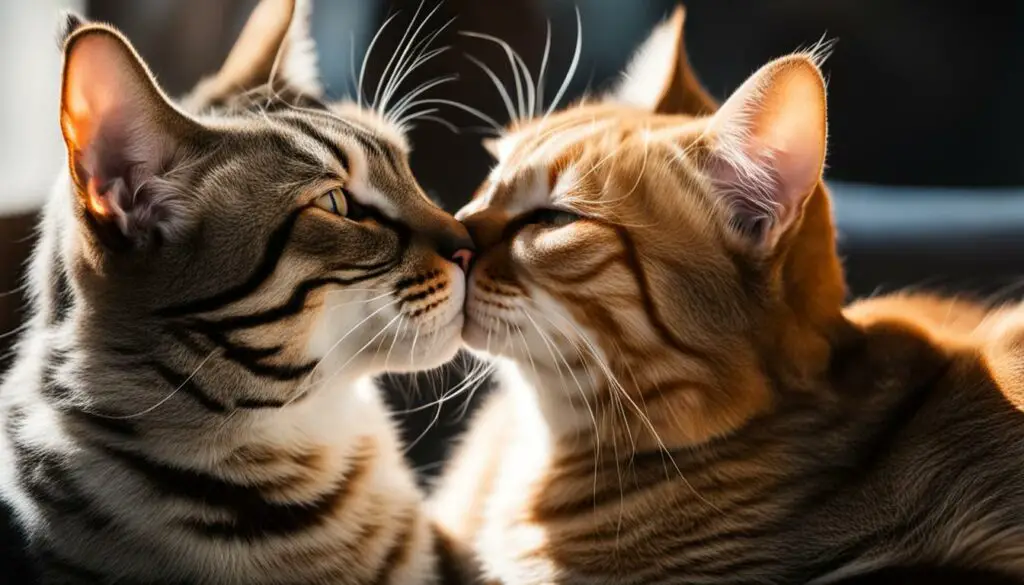
What About Cats Who Don’t Headbutt?
While headbutting is a common behavior among cats, not all felines engage in it. Each cat has its own unique personality and communication style, and some may prefer alternative ways of bonding or expressing themselves. If your cat doesn’t headbutt, don’t worry—it doesn’t necessarily mean there is an issue with your relationship or their social interactions. Cats are highly individualistic creatures, and they may have other ways of showing affection or establishing connections.
Understanding cat headbutting and its role in cat-to-cat communication can deepen our appreciation for the complexity of feline social dynamics. By respecting and interpreting their unique behaviors, we can forge stronger connections with our feline friends and create a harmonious environment for them to thrive.
Cat Headbutting and Territory
When cats engage in headbutting, it is not necessarily about marking territory in the traditional sense. Instead, it is more about creating a scent to indicate that an area is safe and familiar. Cats use headbutting as a form of scent communication to establish their presence and ensure a sense of familiarity in their environment.
By rubbing their heads against people or objects, cats deposit their pheromones and create a scent that represents their presence. This scent serves as a form of communication to other cats and animals, signaling that the area has been claimed and is part of their territory.
It’s important to understand that cat headbutting and territorial marking are not aggressive behaviors. Instead, they are natural ways for cats to establish their presence and maintain a sense of security in their surroundings. If you notice your cat headbutting objects or people, it’s a sign that they feel comfortable and secure, and are trying to create a familiar environment for themselves.
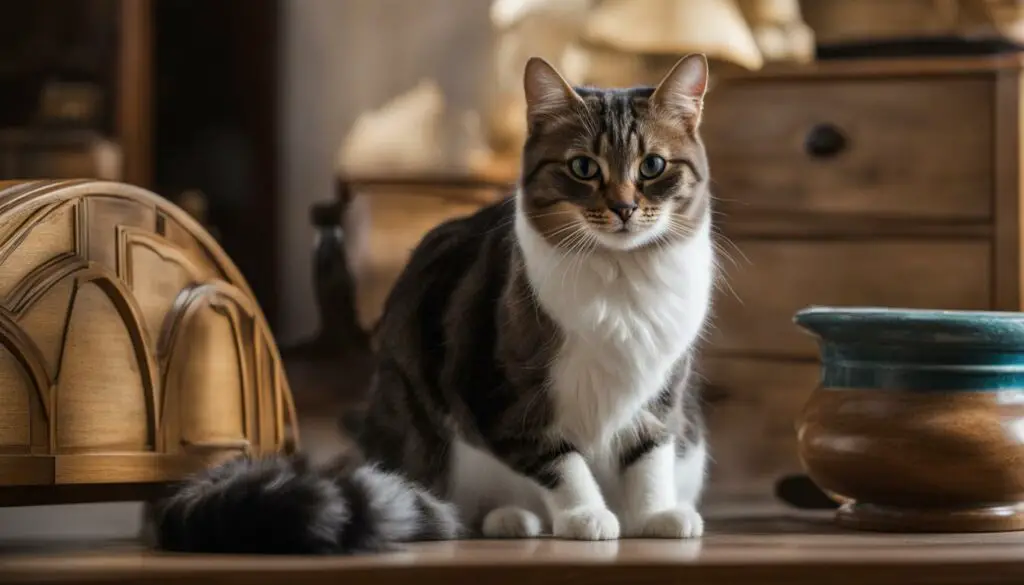
The Importance of Scent Communication
Scent communication plays a crucial role in a cat’s life. By leaving their scent through headbutting and other behaviors like rubbing against furniture and scratching posts, cats create a familiar environment that provides them with a sense of comfort and security.
Through scent communication, cats can also establish social bonds and mark their social hierarchies. By sharing scents through headbutting, cats can create a cohesive group dynamic and reaffirm their social connections within their feline social structures.
Creating a Cat-Friendly Space
To support your cat’s natural behavior of headbutting and scent marking, it’s important to create a cat-friendly space in your home. This includes providing scratching posts, vertical spaces, and hiding spots for your cat to explore and mark with their scent.
Additionally, keeping a consistent routine and providing environmental enrichment, such as interactive toys and puzzles, can help alleviate any potential stress or territorial issues. By understanding and respecting your cat’s need for scent communication, you can create an environment where they feel secure and confident.
What if My Cat Doesn’t Headbutt?
Just like humans, cats have their own unique personalities and ways of expressing themselves. While cat headbutting is a common behavior, not all cats engage in it. So, if your cat doesn’t headbutt, there’s no need to worry. It doesn’t necessarily indicate a problem with their behavior or bond with you. It’s simply a variation in cat behavior and individuality.
Cat headbutting is a form of communication, and cats have different ways of expressing themselves. Some cats may prefer other forms of interaction, such as rubbing against your legs or purring. These behaviors can also indicate affection and a sense of security. It’s important to pay attention to your cat’s overall behavior and body language to understand their unique way of connecting with you.
Remember, every cat is different, and what matters most is building a strong bond based on trust and understanding. Respect your cat’s individuality and provide them with a safe and enriched environment where they can express themselves in their own way. By appreciating and accepting your cat for who they are, you can strengthen your relationship and create a loving and rewarding companionship.
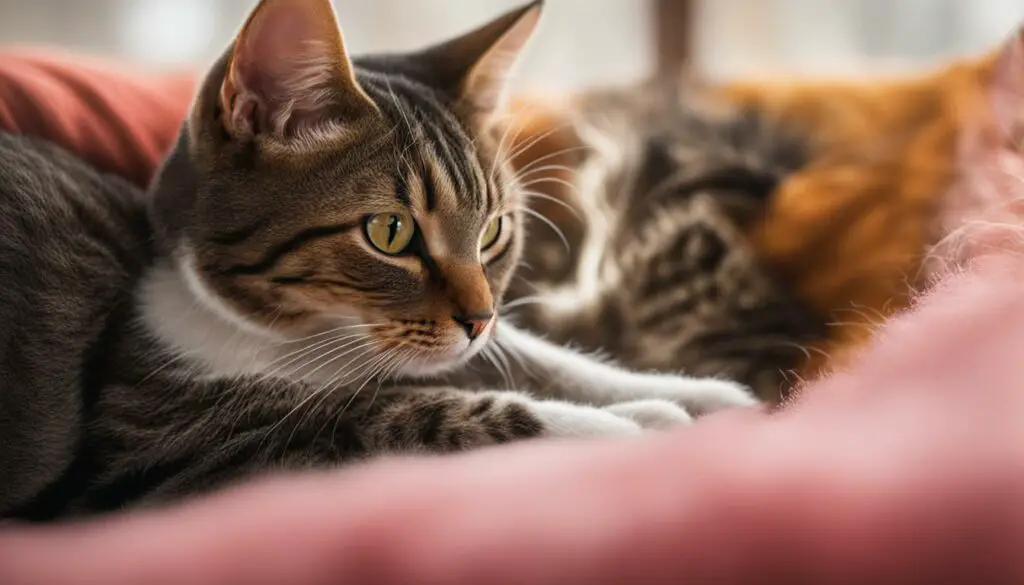
Understanding Your Cat’s Preferences
- Observe your cat’s body language and behavior.
- Pay attention to how they interact with you and their surroundings.
- Offer different types of affection, such as gentle pets or play sessions.
- Provide a variety of toys and enrichment activities to keep them mentally stimulated.
- Respect their personal space and give them the freedom to choose when they want attention.
- Consult with a veterinarian or cat behaviorist if you have concerns about your cat’s behavior.
Understanding and accepting your cat’s individuality is key to fostering a strong and loving bond. Enjoy the unique ways in which your cat expresses their affection and trust, whether it’s through headbutting or other forms of communication.
Have you ever wondered why your cat loves to headbutt you? Cat headbutting, also known as cat bunting, is a common behavior that cats engage in to deposit their pheromones and communicate with their environment. It serves various purposes, including self-soothing, bonding with other cats, marking territories, and creating a sense of familiarity. In this article, we will delve into the reasons behind why cats headbutt and unravel the fascinating world of feline communication.
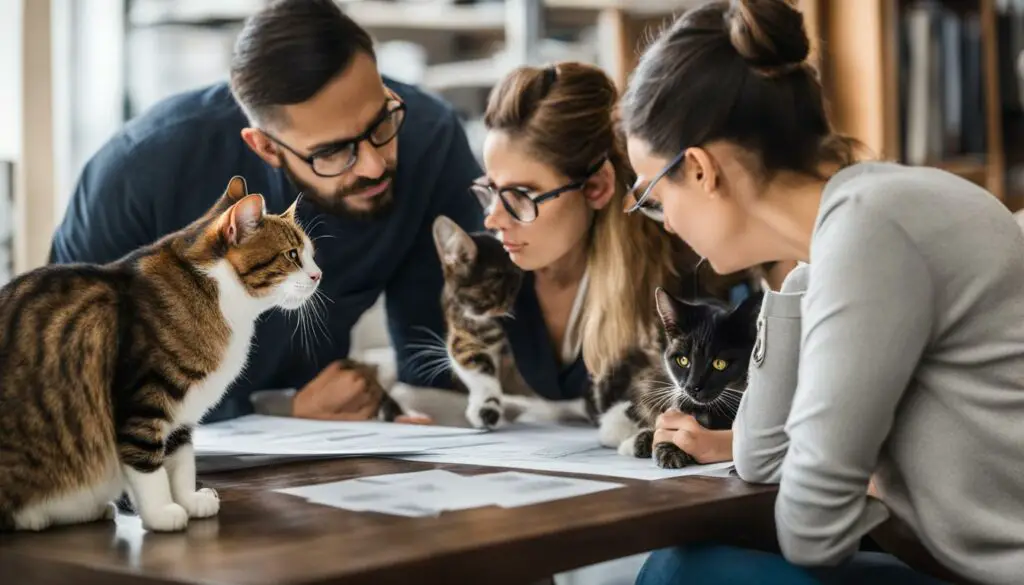
- Cat headbutting is primarily a way for cats to deposit their scents and engage in affiliative displays.
- It signifies their trust and comfort with their owners and serves as a form of communication within their social structures.
- The behavior is also seen in larger feline species, highlighting its importance in establishing social bonds.
- Understanding the context in which a cat headbutts can help interpret its meaning and ensure the cat’s well-being.
- Reciprocating the behavior by gently leaning in or offering your head can reinforce the bond between a cat and its owner.
By exploring the expert insights on cat headbutting and understanding its significance, we can enhance our understanding of our feline companions and strengthen our bond with them.
Responding to Cat Headbutts
When a cat headbutts me, I see it as a sign of affection and trust. It’s their way of saying, “Hey, I feel safe and comfortable with you.” As a cat owner, there are a few ways I respond to cat headbutts to reciprocate their affection.
Gentle Leaning In
One way I respond to a cat headbutt is by gently leaning in towards the cat. This mimics their behavior and shows them that I acknowledge their affection. It’s important to do this slowly and softly so as not to startle or overwhelm the cat.
Offering My Head
Another way I respond to cat headbutts is by offering my head for them to rub against. Cats have scent glands in their cheeks, so when they rub their head against you, they are leaving their scent as a way to mark you as their own. By offering my head, I allow them to continue this behavior and strengthen our bond.
Overall, it’s important to let the cat dictate the level of interaction. If they want more headbutts or affectionate gestures, they will let you know. Providing gentle pets and allowing them to initiate further interactions can help reinforce the bond between you and your furry friend.
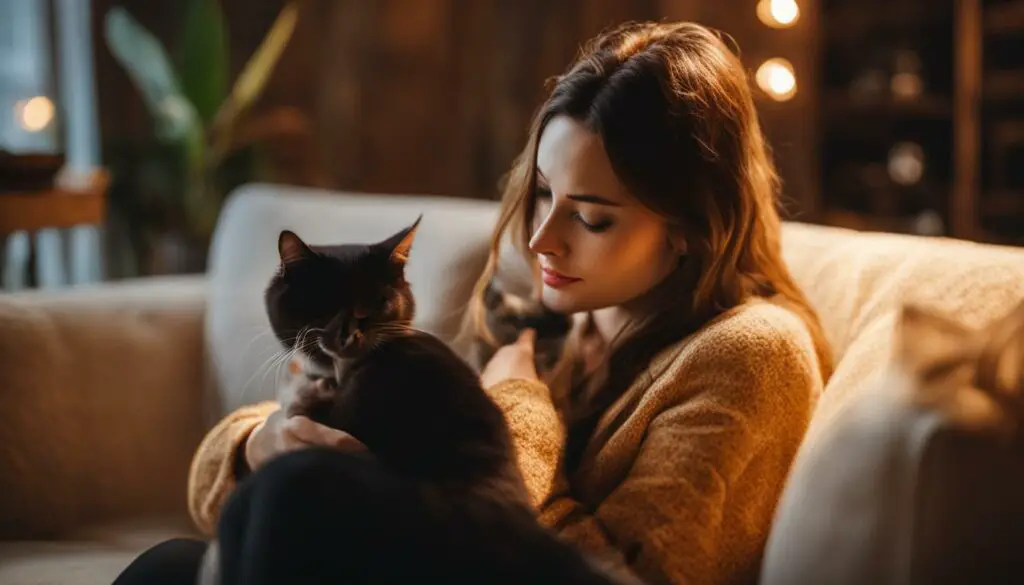
| Ways to Respond to Cat Headbutts | Description |
|---|---|
| Gentle Leaning In | Leaning towards the cat to acknowledge their affection |
| Offering My Head | Allowing the cat to rub their head against mine, reinforcing our bond |
Understanding Context in Cat Headbutting
When it comes to cat headbutting, interpreting the behavior in different contexts is key to understanding its meaning. Cats engage in headbutting for a variety of reasons, and by paying attention to the circumstances surrounding the behavior, we can gain valuable insights into our feline companions.
In the context of bonding with other cats, headbutting is a sign of trust and social connection. When cats headbutt each other, they are exchanging scents and reinforcing their affiliation. It’s a way for them to establish a sense of familiarity and create a cohesive group dynamic within their social structure.
On the other hand, when a cat headbutts its owner, it can signify both trust and a desire for attention and affection. The act of headbutting is a cat’s way of depositing its scent on their owner and marking them as part of their familiar territory. It’s a display of comfort and a way for cats to communicate their bond with their human.
| Context | Meaning |
|---|---|
| Bonding with other cats | Establishing trust and social connection |
| Headbutting owners | Displaying trust, marking territory, seeking attention |
| Stress or discomfort | Indicating potential underlying issues |
It’s important to consider the overall demeanor of the cat and the environment in which the headbutting occurs. If a cat headbutts excessively or displays signs of stress or discomfort alongside the behavior, it may be an indication of underlying issues that need attention. Creating a cat-friendly space and providing a calm environment can help alleviate any potential concerns.
By understanding the different contexts in which cats headbutt, we can better interpret their behavior and strengthen our bond with them. Whether it’s a sign of trust and affiliation with other cats or a display of affection and comfort with their owners, headbutting is a fascinating aspect of feline communication that allows us to connect with our feline friends on a deeper level.
Headbutting vs. Head Pressing
When it comes to cat behavior, it is essential to distinguish between headbutting and head pressing. Headbutting, as discussed earlier in this article, is a normal behavior in cats that serves various purposes such as marking territory and expressing affection. On the other hand, head pressing is a behavior that may indicate an underlying health issue in cats.
Head pressing involves a cat forcefully pushing its head against a hard surface, such as a wall or furniture. This behavior can be a cause for concern as it is not a natural or typical behavior in cats. It may be a sign of neurological problems, toxicity, or even brain tumors. If you observe your cat engaging in head pressing, it is crucial to consult a veterinarian to rule out any potential health issues.
While headbutting is a normal and healthy behavior in cats, head pressing should never be ignored. It is essential to monitor your cat’s behavior closely and seek professional veterinary advice if you notice any abnormal or concerning behaviors.
Remember, headbutting is a way for cats to communicate and bond with their owners and other cats, while head pressing may be a sign of a serious health condition that requires immediate attention.
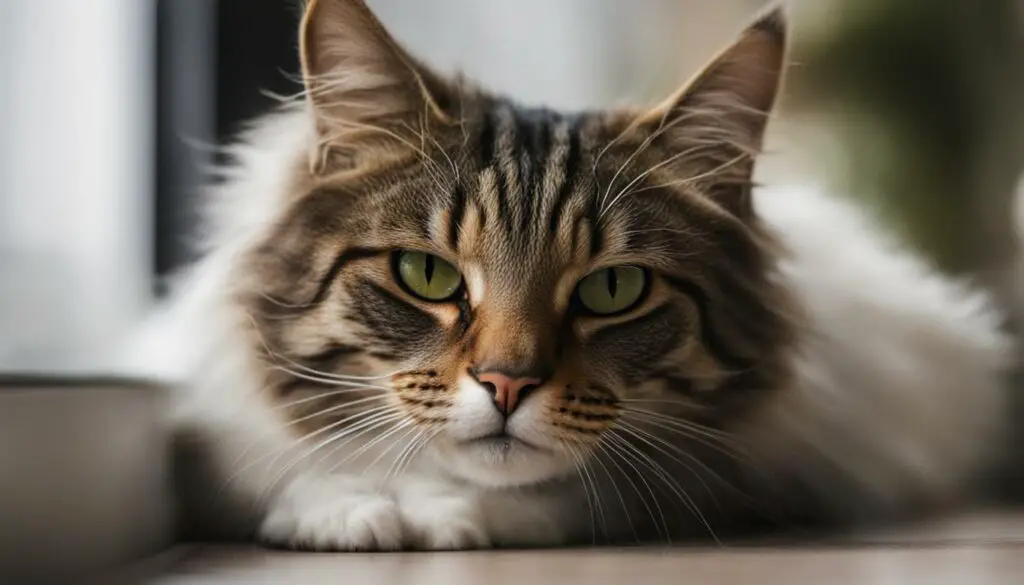
Understanding Cat Headbutting: The Language of Feline Communication
When it comes to understanding our feline companions, one of the intriguing behaviors they exhibit is headbutting. Cat headbutting, also known as cat bunting, plays a crucial role in feline communication and social interaction. By rubbing their heads against objects or people, cats leave behind their scent through specialized glands, conveying important messages to their surroundings.
Headbutting serves various purposes in the feline world. It helps cats create a sense of familiarity, mark their territories, and establish social bonds with other cats. When a cat headbutts a person, it can also be seen as a display of trust and affection. By interpreting this behavior, we can gain valuable insights into the inner workings of our cats’ minds and strengthen our bond with them.
To better understand headbutting, it’s essential to pay attention to the context in which it occurs. Cats use headbutting as a form of scent communication, leaving their mark and asserting their presence in their environment. By appreciating the significance of this behavior, we can create a cat-friendly space that promotes their sense of security and enhances their overall well-being.
The Fascinating World of Feline Communication
It’s fascinating to explore the intricacies of feline communication. Cats have a unique language that goes beyond vocalizations, and headbutting is just one aspect of it. By observing and interpreting their behaviors, we can build a stronger connection with our cats and provide them with the love and care they deserve.
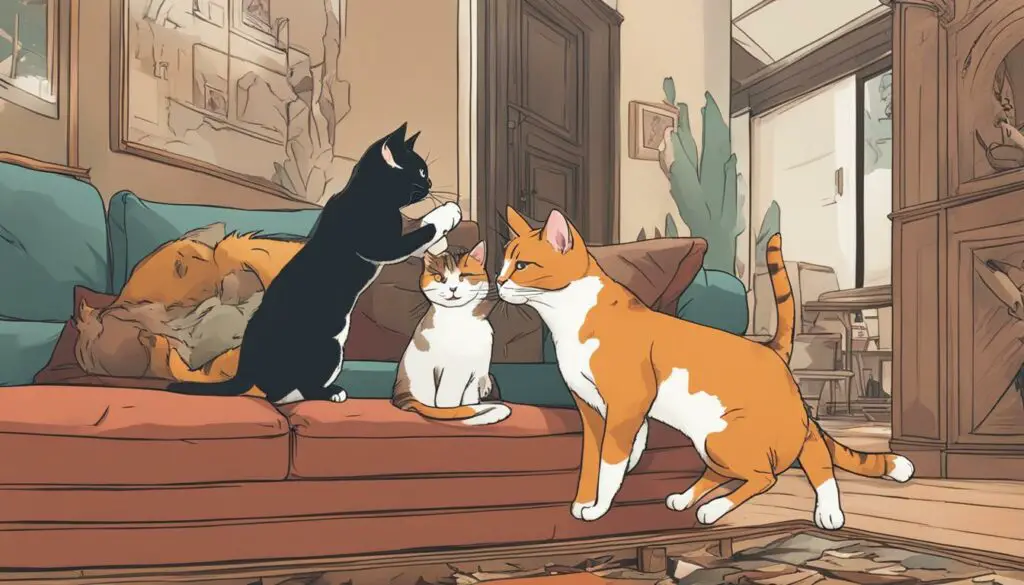
| Reasons for Cat Headbutting | Social Significance |
|---|---|
| Cat bunting helps create a colony scent | Establishes a sense of familiarity |
| Allows cats to mark territories and map safe zones | Communicates comfort and trust |
| Enables bonding with other cats | Strengthens social connections |
“Through headbutting, cats leave behind a trail of their unique scent, creating a network of communication and reinforcing their place in the world.”
Remember, every cat is unique, and while headbutting is a common behavior, not all cats engage in it. Just like humans have different ways of expressing themselves, cats exhibit individuality in their communication styles. By embracing and understanding our cats’ uniqueness, we can forge a bond rooted in love, trust, and mutual respect.
Understanding Cat Headbutting: The Language of Feline Communication
As a cat owner, I have always been fascinated by the unique behaviors of my feline companions. One behavior that never fails to intrigue me is cat headbutting. Whether it’s rubbing their head against my leg or snuggling up close and gently pressing their forehead against mine, I have often wondered why cats engage in this endearing behavior.
After doing some research, I discovered that cat headbutting, also known as cat bunting, serves as a form of communication for our furry friends. It’s their way of depositing their pheromones and marking their presence, whether it be on objects, humans, or other cats. By rubbing their scent glands located in their cheeks, forehead, and other areas, cats create a sense of familiarity and comfort in their environment.
But cat headbutting is more than just a territorial marking. It is also a way for cats to express affection and strengthen their social bonds. When a cat headbutts you, it’s their way of showing that they trust and feel safe with you. It’s a gesture of love and acceptance that deepens the bond between cat and owner.
Understanding cat headbutting is an important aspect of feline communication. By recognizing and respecting this behavior, we can better understand our cats’ needs and emotions. So the next time your furry friend headbutts you, cherish the moment and reciprocate the gesture with gentle affection. It’s their way of saying, “I love you” in their own unique language.
FAQ
Why do cats headbutt?
Cats headbutt to deposit their pheromones, communicate with their environment, bond with other cats, mark territories, and create a sense of familiarity.
What is cat headbutting?
Cat headbutting, or cat bunting, refers to the behavior of a cat rubbing their head against a person or object and then moving to rub their cheek. It is a form of communication using scent glands located in various parts of their body.
What are the reasons for cat bunting?
Cat bunting serves purposes such as creating a colony scent, marking their owners, bonding with other cats, mapping safe zones, and engaging in self-soothing behaviors.
Is cat bunting a sign of affection?
Yes, cat bunting can be seen as a display of trust and comfort. Cats headbutt people they trust and feel safe with as a way to show affection.
Do cats headbutt each other?
Yes, cats engage in headbutting with other cats to create a colony scent and establish a sense of safety and bonding within their social structures.
Does cat headbutting mark territory?
Cat headbutting is not about marking territory in the traditional sense. It is more about creating a scent to indicate a safe and familiar environment.
What if my cat doesn’t headbutt?
Not all cats engage in headbutting behavior, and that is normal. Each cat has its own unique personality and way of expressing themselves.
What do experts say about cat headbutting?
According to expert cat behavior consultants, cat headbutting is primarily a way for cats to deposit their scents and engage in affiliative displays, signifying trust and comfort with their owners and other cats.
How should I respond to cat headbutts?
Reciprocating the behavior by gently leaning in or offering your head can be a way to respond. However, let the cat decide if they want to engage further.
How do I interpret cat headbutting in different contexts?
Consider the environment and other behaviors. Excessive headbutting or other concerning behaviors may indicate stress. Creating a cat-friendly space can help alleviate concerns.
What is the difference between headbutting and head pressing in cats?
Headbutting is a normal behavior, while head pressing can be a sign of underlying health conditions. Consult a veterinarian if a cat forcefully pushes its head against a hard surface or displays disoriented behavior.
Source Links
- https://www.therescuevets.com/education-resources/cat-care-tips/why-cats-headbutt/
- https://www.thewildest.com/cat-behavior/why-do-cats-headbutt
- https://www.dailypaws.com/cats-kittens/behavior/common-cat-behaviors/why-do-cats-headbutt

